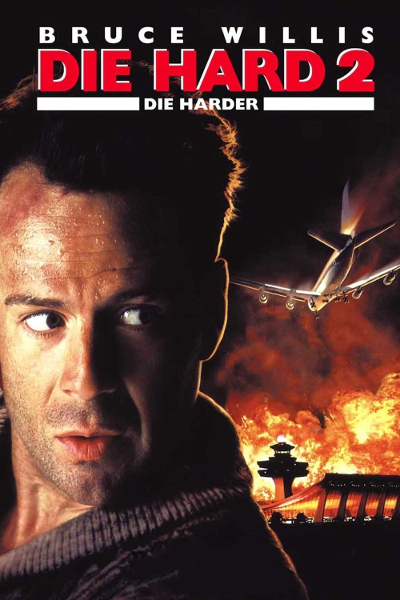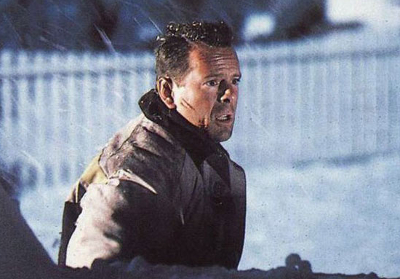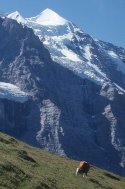|
Children of Bond - Die Hard 2

Little
time was wasted moving a sequel to Die Hard into production after the
success of the first film. The main question was what could happen to
John McClane this time in the absence of Hans Gruber and the Nakatomi
Plaza? Whatever option they took it was unavoidably going to be
somewhat unbelievable that McClane was such a magnet for trouble,
forever finding himself in these explosive situations. There was money
to be made though and ultimately it's just a film.No
one complains that it's unrealistic having James Bond forever encountering
larger than life villains or outlandish situations but then James Bond
is a fantasy secret agent not a New York policeman. Therein lay the
rub. Like it not, the McClane character was going to lose some
plausibility if a franchise was to be developed around the first
picture. The sequel had double the budget of the first film and
although it earned some solid reviews and is generaly regarded to be a
competent and entertaining film it does provide evidence that bigger is
not neccesarily better.Doug
Richardson, later a novelist and screenwriter on Bad Boys, had
impressed with an unproduced spec script called Hell Bent... and Back
and was hired to write Die Hard 2 while 1988's Die Hard was still in
cinemas. The producer Larry Gordon wanted him to adapt Walter Wager's
book 58 Minutes into Die Hard 2. 58 Minutes was about an NYPD captain
named Frank Malone waiting for his daughter at JFK international
airport. The airport is taken over by a mysterious villain who gives
the authorities 58 minutes to accept his demands before planes start
crashing. Malone must somehow save his daughter and to make matters
worse a blizzard is coming in.Richardson's
approach to the sequel was: "Using the novel 58 minutes as a rough
sketch, it was about putting John McClane in the middle of it. Wrong
place wrong time. And let the natural suspense drive the action without
winking at the audience. Essentially, it was about making it a stand
alone."Sadly, John McTiernan was
unavailable to direct Die Hard 2 because he was busy on The Hunt For
Red October. One wonders if - in hindsight - they should have put Die
Hard 2 back and waited for him to be available because he did plan to
direct the Die Hard sequel before the scheduling conflict. The man
chosen to replace McTiernan was Finnish director Renny Harlin. Harlin
was a young up and coming filmmaker who had just directed the horror
pictures Prison and A Nightmare on Elm Street 4: The Dream Master.
Harlin's first film (the Finnish funded) Born American opened at number
nine in the United States and put him on the map.Harlin
would go on to direct arguably the best of the many Die Hard variants
in 1993 with Sylvester Stallone's Cliffhanger. Cliffhanger was
essentially Die Hard on a mountain range. Harlin went off the boil in
the end but he was a much in demand director for most of the nineties
and around the time of Die Hard 2 was hired to direct Alien 3 before
leaving the production due to creative differences. Harlin also turned
down the chance to direct GoldenEye a few years later.Harlin's
take on Die Hard 2 was this: "My goal was to replicate the experience
of the first one without copying it. I think it's important to be
faithful to a character and this applies to his behavior, his sense of
humor and also his limitations. It can be dangerous when stunts make a
down to earth character into a superhero."Michael
Kamen returned to score the film while Oliver Wood was placed in charge
of the cinematography. While Harlin and Wood do a solid enough job,
McTiernan and Jan de Bont can't help but be missed. Die hard 2 does
seem to lack a certain sprinkle of the Die Hard magic they managed to
capture in the first film.Bruce
Willis was - naturally - back as John McClane and this is the only Die
Hard sequel that includes characters from the first film. Bonnie
Bedelia as Holly McClane and William Atherton as the oleaginous
journalist Richard Thornburg find themselves sitting together on one of
the circling planes and Reginald VelJohnson as Sergeant Al Powell is
given a cameo.William Sadler, a
regular television performer who later become known for films like Bill
& Ted's Bogus Journey and The Shawshank Redemption, was signed to
play the villain Colonel Stuart with relative unknown Donald Patrick
Harvey as his second in command Garber. Look for a young John Leguizamo
as one of Sadler's team. Leguizamo said much of his part was cut out in
the editing room. Another of Sadler's team, Robert Patrick, would be
cast as the T-1000 in James Cameron's Terminator 2 the following year.The
wonderful Dennis Franz, well known to television viewers as Norman
Buntz in Hill Street Blues, was cast as the stubborn minded Captain
Carmine Lorenzo, the head of the airport police. Franz would go on to
become even better known for his long running part as Detective Andy
Sipowicz in NYPD Blue. Fred Thompson plays Ed Trudeau, the Chief of
Dulles' operations. Doug Richardson based the character on the man he
met researching airport operations. Thompson was not just an actor but
a politician and served in the United States Senate representing
Tennessee from 1994 to 2003.The
tough looking John Amos was known through films like Coming to America
and took the part of special forces leader Major Grant while Art Evans
takes the role of Leslie Barnes, the chief engineer. Franco Nero, who
plays the dictator General Ramon Esperanza, is a cult actor known for
many films, including Django and Enter the Ninja.The
premise? Once again it is Christmas Eve, two years after the Nakatomi
Plaza caper, and John McClane (wearing a blue checked shirt but you do
get some vague vest action) is at Dulles International Airport in
Washington waiting for his wife Holly to land. He doesn't seem to have
much luck at Christmas though because once again he is soon up to his
neck in trouble. A team of mercenary terrorists, led by the renegade
Colonel Stuart, seize the airport by taking control of the air traffic
control systems. Stuart wants to rescue Ramon Esperanza, the drug baron
dictator of (the fictitious) Latin American country Val Verde.Esperanza
is due to fly in to stand trial and Stuart demands a Boeing 747 to be
put at his disposal to make his escape with the dictator and his team.
If his demands are not met he will start crashing planes. As his wife
is on one of those planes (now circling the airport with its fuel
running low) McClane decides he has no choice but to take matters into
his own hands and try and wrest control of the airport back from Stuart
and his men...One immediate
problem with Die Hard 2 (sometimes known as Die Hard 2: Die Harder on
posters) is that the action is no longer wonderfully self-contained in
the manner of the original. The constrictive setting of the shimmering
skyscraper forced them to be more inventive and was a major part of the
appeal.Here they have an entire
airport and its surroundings to play with and the novelty is
unavoidably lost - making this seem much more like a generic action
film than the first one. There is even a snowmobile chase at one point
and while everyone loves a good snowmobile chase it does feel more like
James Bond than the John McClane character we saw in the first film.
The idea here is that if the first film was riffing on The Towering
Inferno then this is Die Hard meets Airport but the setting and story
simply doesn't work so well this time.The
sequence where McClane uses an ejector seat to escape from a stationary
plane is pure James Bond. So much so that GoldenEye more or less ripped
off this setpiece five years later with Pierce Brosnan in a helicopter!McClane
was somehow more realistic in the first film too, a reluctant hero.
While he has an obvious motivation to intervene here (his wife is on
one of the planes circling above) you do get the impression he'd do so
anyway. It's highly contrived the manner in which he becomes suspicious
of two military types at the start of the film and is soon having a
guns blazing shoot out and scrap with them in some baggage room, thus
stumbling onto Stuart's grand scheme for the first time.
No
one can deny though that Die Hard 2 is a big film that gives you plenty
of bang for your buck - gun fights lovingly framed and staged,
explosions a plenty, spectacular sequences involving aeroplanes. It's a
perfectly competent and entertaining action film but one that just
feels somewhat functional and uninspired when placed alongside its
illustrious predecessor. It's as if they were desperate to get another
film with the Die Hard tag out as soon as possible rather than wait for
anyone to come up with a really great idea or script.Renny
Harlin was fine at this sort of stuff and directed some good action
films (Cliffhanger, The Long Kiss Goodnight) in his day but he lacks
the refinement and panache of John McTiernan. Die Hard 2 throws a lot
of money at the screen but is significantly less stylish and sleek than
McTiernan's film and never generates that rush laden rollercoaster ride
- that spectacular coda upon coda feeling. The first film had a vivid
palette and sheen and this one is very blue and dark at times with a
lot of action taking place at night. The fake dusty snow that frames
proceedings doesn't always convince either.The
biggest problem with the film is probably William Sadler's
villain - a bland and largely charisma free baddie who you can
barely remember after watching the film. The camp antics of Rickman and
Jeremy Irons (who were both very Bond villain) in the first and third
films were much more fun and gave Willis more oppurtunity for verbal
sparring. Hans Gruber was witty, flamboyant and amusing but Sadler is
no fun at all and seems like he's just wandered in from a Steven Segal
film.McClane's cat and mouse game
with the other villains was much more inventive and enjoyable. Hans
Gruber's domain was a high-tech skyscraper that he had complete control
of like a king but Sadler and his men set up a HQ in a windblown shed
in the airport grounds. It's not the same really.As
usual, McClane has to battle the authorities as much as the villains -
especially the chief of airport security Captain Carmine Lorenzo. Fans
of Hill Street Blues and NYPD Blue will enjoy the diminutive walrus
mustached presence of Dennis Franz as Lorenzo. In a radical departure
from his usual parts he essays a diminutive bad tempered walrus
mustached policeman here! I love Dennis Franz so I was happy to see him.The
film lacks the wit of the first one and Willis only gets a few good
wisecracks and laughs from the script (and his improvised gags) so his
verbal jousts with Franz are sorely needed. "Hey Lorenzo, let me ask
you something: what sets off a metal detector first? The lead in your
ass or the s*** in your brains?" Willis throws himself into the action
in his usual fashion and proves that he has more than enough charisma
to carry a Die Hard film on his shoulders without Alan Rickman in
support. He'd arrived as a major film star.One
welcome thing about the film - that at least makes it seem like a blood
relative to the first Die Hard - is the inclusion of some of the key
supporting characters from the original. It's contrived of course but
nice anyway to see these characters again. Die Hard 2 is a lavish and
generally entertaining film but one that perhaps does seem as if it is
going through the motions rather than ever creating anything special or
new with the franchise. It's watchable but tends to wash over you
rather than leave a litter of unforgettable scenes and images in the
memory as the first picture does. If this had been the first Die Hard
film it's doubtful the brand would have become so iconic.Still,
despite feeling more mechanical than Die Hard (you can almost hear Die
Hard 2 desperately grinding through the gears) this is an expensive
sequel that remains very watchable. It has some grand scale stunts and
some solid laughs.- Jake
c 2017
Alternative 007
|

|


